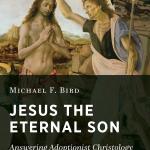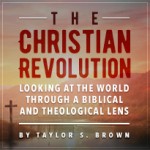As noted in my previous, introductory post for this series, I will be attempting to work my way, chapter by chapter, through Michael Bird’s recent book, Jesus the Eternal Son: Answering Adoptionist Christology (Eerdmans, 2017). And so I will begin, as expected, at the beginning.
Bird opens the first chapter of the book with a brief exposition on the development of various Christologies in the earliest days of the Christian movement. While Bird notes that the discussion in itself is quite complex, he ventures to suggest that the earliest Christological formulations came about as a means of expressing what the earliest Christians believed God had done in the Christ event. To quote Bird:
At the risk of simplification, I would suggest that early Christologies emerged as the attempt to express, in belief and devotion, what the earliest Christ-believers thought God had revealed in the life, passion, resurrection, and exaltation of Jesus of Nazareth. In addition, there was a palpable need to make sense of what they had experienced of Jesus in their own communal and interior religious life (p. 1).
Thus, the earliest Christological formulations emerged out of Christian communities trying to articulate what they both believed and practiced in worship. Again, Bird:
This [the process of seeking to formulate what the early Christian communities believed about Christ and practiced in worship] led to the creations of narratives and propositions that attempted to answer a double-sided question: (1) Who is Jesus? and (2) Who is God in light of the memory of Jesus and the continuing experience of Jesus? This is where Christology began (p. 2).
Thus—as one might expect—the earliest questions and answers about who exactly Jesus was and is (Christology) directly impinged upon the understanding of who God the Father was and is (theology proper). And all of this was done based upon the variety of material and descriptors used of Jesus in the New Testament texts themselves. As Bird rightly notes, the “raw materials” that would go on to be refined into the formulations of Nicene Christological orthodoxy were present from the very beginning in the New Testament (p. 4).
Of course, the movement from the raw data of the New Testament to the Nicene Creed was not an easy process. A variety of external factors—ranging from disagreements with proto-Rabbinic Judaism, to the adaptive and confrontational process with the Hellenistic world, to the dissemination of non-apostolic/non-apostolically-rooted “gospels,” among others—led to a variety of different ways of understanding who Christ was and is. Bird thus proposes that there was not a single, unified Christology prior to Nicea. But neither was there a limitless number of mutually exclusive Christologies swirling around either. Instead, a common core of mutually reinforcing Christological expressions began to cluster together, what Bird calls “early christologizing” (p. 5). Such “christologizing” was conducted and rooted in the communal and common belief and practice of the early, proto-orthodox communities. Quoting Bird:
The upshot [of “early christologizing”] was that a cohesive mode of discourse and mutually recognized patterns of worship gradually emerged. Concurrently, seemingly incongruent beliefs and practices began to be pushed to the margins when they did not meet with consensus or find reciprocation in the burgeoning church communities (p. 5).
These incongruent beliefs about Jesus came to be known, of course, as heresies. And contra the pop-level cultural narrative that they were all on equal (if not stronger) footing to proto-orthodoxy before Nicea, they were naturally deemed to be wrong by the early Christian communities on their own lack of merit. Namely, the various heresies (1) failed to be built on apostolic foundations, (2) seemed to lack warrant in the Scriptures, (3) seemed to lack internal coherency, and (4) put forward dubious consequences for the Christian life (p. 6).
And yet despite these problems, the heresies continued (and continue) to exist on the fringes of the Christian communities, always managing to draw a handful into their shallow traps. And this is where Bird comes to the main topic of the book: the heresy of adoptionism. Of course, adoptionism is that ancient heresy that claims that the man Jesus was only adopted as the Son of God in an honorific manner sometime after his birth (whether that was at his baptism or his resurrection). As Bird observes, all the various strains of adoptionism have two primary components: (1) Divine sonship is not intrinsic to Jesus, and (2) that any status of divine sonship is merely honorific; a legal fiction bestowed upon him (p. 7).
And while adoptionism is arguably the oldest of the Christological heresies it is also one of the most long-lived heresies, with many scholars still assuming that adoptionism is the earliest accessible Christology.
But what if this assumption is simply wrong? What if adoptionism has its roots in neither the NT texts nor in the immediate post-apostolic period, but rather in the early to mid-second century? Well that would change everything in the debate. And that is the proposal that Bird ends the first chapter with. Bird states that the goal of the book thus:
My objective is to question this quasi-consensus that the earliest retrievable Christology was adoptionist. To that end I intend to develop two central claims: (1) the first Christologies were hastily devised venerations of Jesus as a divine figure, which then crystallized over the next twenty years into a series of presentations of Jesus that were variations of a theme of incarnationalism, even if the details were still to be fully worked out; and (2) adoptionism originated as a particular second-century phenomenon driven largely by internal debates about preferred texts and socio-religious influences on reading them. So when did Jesus get adopted as the Son of God? As we will see, probably in the second century, though precisely when will remain a matter of debate (p.9).
So there you have it readers. Bird, like a modern Australian version of Irenaeus of Lyons, has opened the first chapter with a bang and fired the opening volley at the “adoptionist quasi-consensus” within biblical and early Christian scholarship. How will he back up such claims? I guess we’ll just have to keep going through the book to find out.
Soli Deo Honor et Gloria











